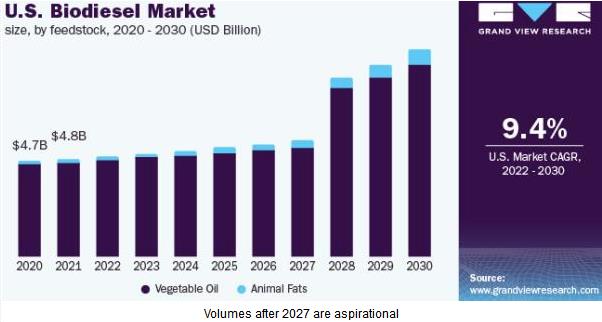The demand for biodiesel using soy oil as a feedstock has the potential to disrupt the relative proportion of acreages planted for corn and soybeans in the U.S. The proposed program would impact the availability and cost of soybean meal. According to the American Soybean Association, crushing capacity in the U.S. will increase in 2023 by 34 percent, equivalent to 750 million bushels per year, compared to the current capacity of 2.2 million bushels per year from 60 plants. Increased capacity will be derived from 13 new plants and the expansion of ten existing facilities.
Demand for soybeans to produce soy oil for biodiesel, domestic food and the export market will obviously increase the price of soybeans unless there is a marked reduction in shipments to existing overseas customers. This situation might in any event arise if political conflict between the U.S. and China erupts as a result of overt support for Russia over the surrogate war in Ukraine.
According to the December USDA- WASDE report, 44.1 percent of the 4.3 million bushels of soybeans produced will be exported from the 2022 crop. If demand increases by 30 percent over a three-year period, and exports remain at the current level, corn will have to be displaced to allow production of the required incremental quantity of soybeans. The 2022 soybean crop was harvested from 86.6 million acres with corn from 80.8 million acres. Conversion of 24 million acres currently planted to corn would result in a shortfall of 4,169 million bushels, assuming the 2022 yield of 172 bushels per acre. Given that domestic use of corn is 12,025 million bushels and exports will attain 2,075 million bushels, a 30 percent reduction in production would have a profound effect on domestic price. Although soybean meal may fall in price based on availability, corn would be proportionately higher.

It is recognized that diversion of at least one third of the corn crop to ethanol, resulted in higher prices to the livestock feed industry. Increased production of soybeans to produce soy oil for biodiesel has the potential to also escalate the cost of livestock production.
The biofuels program is an immense boondoggle created at a time when the U.S. was reliant on unfriendly nations for importation of hydrocarbon energy. The U.S. is now a net exporter of crude oil and LNG. Biofuels have long since exceeded their economic justification, other than to the favored few. The row crop community, their commodity associations and the renewable fuels industry with their influence on both parties in Congress have perpetuated an artificial demand through mandates. This has effectively imposed an indirect tax on all who eat, drive or purchase any item that is transported.